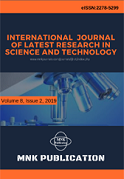DOI:10.29111/ijlrst ISRA Impact Factor:3.35, Peer-reviewed, Open-access Journal
Research Paper Open Access
International Journal of Latest Research in Science and Technology Vol.3 Issue 5, pp 46-52,Year 2014
Correspondence should be addressed to :
Received : 31 October 2014; Accepted : 31 October 2014 ; Published : 31 October 2014

| Download | 125 |
|---|---|
| View | 184 |
| Article No. | 10392 |
Sex ratio, morphometric characteristics, age and growth for four fish species from Bulgarian Black Sea were examined. A total of 2013 individuals from 4 families, were caught between May 2006 and December 2010. Female: male sex ratio varied from 1:0.3 in Trachurus mediterraneus ponticus to 1:1.9 in Sarda sarda. According to the age readings, distribution varied from I to VI year. The von Bertalanffy equation and growth performance index were determined by FiSAT II software in Alosa imaculata, Engraulis encrasicolus, Trachurus mediterraneus ponticus and Sarda sarda. Asymptotic values for total length (L∞) ranged from 82.97 cm for S. sarda to 14.60 cm for E. encrasicolus. Growth rates (k) varied from 0.4794 year−1 for E. encrasicolus to 0.1044 year−1 for T. mediterraneus. The data sets were limited in most cases, thus this study provides preliminary population parameters only, but for species for which information is scarce.
Copyright © 2014 Maria YANKOVA et al. This is an open access article distributed under the Creative Commons Attribution 4.0 International (CC BY 4.0) license which permits unrestricted use, distribution, and reproduction in any medium, provided the original work is properly cited.
Maria YANKOVA , " Preliminary Estimates Of The Population Parameters Of Four Species In The Bulgarian Black Sea Coast ", International Journal of Latest Research in Science and Technology . Vol. 3, Issue 5, pp 46-52 , 2014

MNK Publication was founded in 2012 to upholder revolutionary ideas that would advance the research and practice of business and management. Today, we comply with to advance fresh thinking in latest scientific fields where we think we can make a real difference and growth now also including medical and social care, education,management and engineering.

We offers several opportunities for partnership and tie-up with individual, corporate and organizational level. We are working on the open access platform. Editors, authors, readers, librarians and conference organizer can work together. We are giving open opportunities to all. Our team is always willing to work and collaborate to promote open access publication.

Our Journals provide one of the strongest International open access platform for research communities. Our conference proceeding services provide conference organizers a privileged platform for publishing extended conference papers as journal publications. It is deliberated to disseminate scientific research and to establish long term International collaborations and partnerships with academic communities and conference organizers.